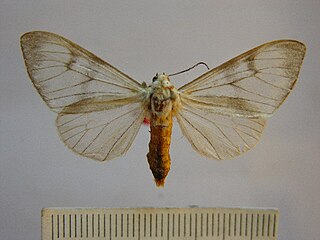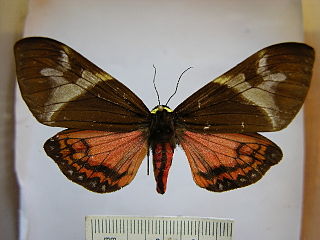Related Research Articles

The Arctiinae are a large and diverse subfamily of moths with around 11,000 species found all over the world, including 6,000 neotropical species. This subfamily includes the groups commonly known as tiger moths which usually have bright colours, footmen which are usually much drabber, lichen moths, and wasp moths. Many species have "hairy" caterpillars that are popularly known as woolly bears or woolly worms. The scientific name Arctiinae refers to this hairiness. Some species within the Arctiinae have the word tussock in their common name because they have been misidentified as members of the Lymantriinae subfamily based on the characteristics of the larvae.

The Arctiini are a tribe of tiger moths in the family Erebidae.
Josiomorphoides is a genus of moths in the subfamily Arctiinae. The genus was described by Hering in 1925.

Phaloe is a genus of moths in the subfamily Arctiinae. The genus was erected by Félix Édouard Guérin-Méneville in 1838.
Sermyla is a monotypic moth genus in the subfamily Arctiinae. Its only species, Sermyla transversa, is found in Brazil. Both the genus and species were first described by Francis Walker in 1854.

The Erebidae are a family of moths in the superfamily Noctuoidea. The family is among the largest families of moths by species count and contains a wide variety of well-known macromoth groups. The family includes the underwings (Catocala); litter moths (Herminiinae); tiger, lichen, and wasp moths (Arctiinae); tussock moths (Lymantriinae), including the arctic woolly bear moth ; piercing moths ; micronoctuoid moths (Micronoctuini); snout moths (Hypeninae); and zales, though many of these common names can also refer to moths outside the Erebidae. Some of the erebid moths are called owlets.
Coreura phoenicides is a moth of the subfamily Arctiinae. It was described by Herbert Druce in 1884. It is found in Guatemala and Costa Rica.

Dysschema amphissum is a moth of the family Erebidae first described by Carl Geyer in 1832. It is found in south-eastern Brazil, ranging from southern Minas Gerais and Rio de Janeiro, south to Rio Grande do Sul.

Dysschema arema is a moth of the family Erebidae first described by Jean Baptiste Boisduval in 1870. It is found in Nicaragua, Venezuela, Peru, Brazil and Ecuador.

Dysschema boisduvalii is a moth of the family Erebidae first described by Jan van der Hoeven in 1840. It is found in Paraguay, Colombia, Brazil and Argentina.

Dysschema eurocilia is a moth of the family Erebidae first described by Pieter Cramer in 1777. It is a common species throughout tropical America, where it has been recorded from the Antilles, Central America and South America.

Dysschema perplexum is a moth of the family Erebidae first described by William Schaus in 1910. It is found in Panama and Costa Rica.

Dysschema lygdamis is a moth of the family Erebidae first described by Herbert Druce in 1884. It seems restricted to the mountains of Costa Rica and Panama.
Dysschema pictum is a moth of the family Erebidae first described by Félix Édouard Guérin-Méneville in 1844. It is found in Brazil.

Dysschema thetis, the northern giant flag moth, is a moth of the family Erebidae. The species was first described by Johann Christoph Friedrich Klug in 1836. It is found from the south-western United States to north-western Mexico.

Dysschema thyridinum is a moth of the family Erebidae first described by Arthur Gardiner Butler in 1871. It is found in Ecuador and Peru.
Dysschema viuda is a moth of the family Erebidae first described by William Schaus in 1910. It is found from Costa Rica to Ecuador.

Josiomorpha penetrata is a moth of the subfamily Arctiinae first described by Francis Walker in 1865. It is found from southern Mexico to Guatemala.
Josiomorphoides gigantea is a moth of the subfamily Arctiinae first described by Herbert Druce in 1897. It is found in Panama and Colombia.
Pseudophaloe schausii is a moth of the family Erebidae first described by Henry Edwards in 1884. It is found in Mexico and Guatemala.
References
| Wikimedia Commons has media related to Josiomorphoides dognini . |
| Wikispecies has information related to Josiomorphoides dognini . |
- ↑ Savela, Markku. "Josiomorphoides flammata (Dognin, 1909)". Lepidoptera and Some Other Life Forms. Retrieved September 6, 2019.
- ↑ Becker, Vitor O. (September 15, 2013). "Taxonomic changes in the Neotropical Pericopina and Ctenuchina moths (Erebidae, Arctiinae, Arctiini), with description of new taxa" (PDF). The Journal of Research on the Lepidoptera. 46: 53–66. Archived from the original (PDF) on December 24, 2013.